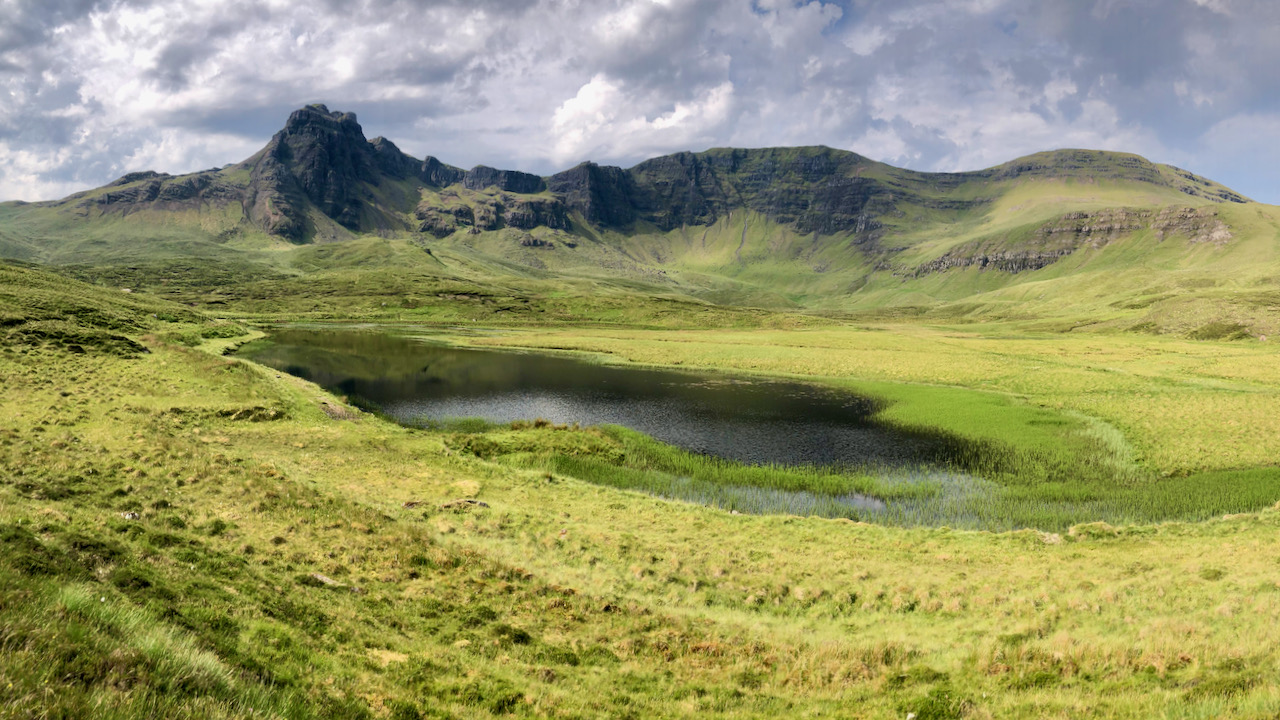What had fascinated me was the peculiar wording on the O.S. map, indicating the presence of a “Dismantled Railway,” a six kilometres stretch from the Inver Tote coastline, winding its way towards Loch Cuithir, nestled beneath the formidable Sgurr a’ Mhadaidh Ruaidh, aptly dubbed ‘the hill of the red fox.’
As it turned out, Loch Cuithir had once been a hub of bustling industrial activity. Its depths harboured a bountiful reservoir of fossilised shells, from which the precious substance known as diatomite could be extracted1‘Skye, Loch Cuithir | Canmore’. 2023. Canmore.org.uk <https://canmore.org.uk/site/11313/skye-loch-cuithir> [accessed 17 June 2023]. In the late 19th and early 20th centuries, diatomite held significant value, boasting a myriad of applications ranging from the production of dynamite to toothpaste.
The extraction process involved dredging the diatomite from the loch bottom, after which girls carefully transferred it onto open trays crafted from wire netting. These trays were meticulously arranged in tiers, allowing the wind and sun to hasten the drying process. Indeed, drying the diatomite posed quite the challenge, particularly in the damp climate of Skye, where the substance clung stubbornly to its moisture. Eventually, the diatomite was transformed from clumpy clay to a light, crumbly texture, shedding its sombre grey hue for a pristine white. The surrounding heather and grass became tinged with a fine dusting of diatomite particles2MacCulloch, J.A. “The Misty Isle of Skye”. Page 128/9. Eneas Mackay. 1936.. These newly formed lumps were then packed into sacks and transported on trolleys along the ‘railway’ to the precipice, before being lowered down to the shoreline where they underwent roasting and grinding in a mill, culminating in the creation of a fine, powdery substance, eagerly awaiting shipment aboard waiting vessels3‘Inver Tote, Diatomite Works | Canmore’. 2023. Canmore.org.uk <https://canmore.org.uk/site/191594/inver-tote-diatomite-works> [accessed 17 June 2023]4‘Skye, Inver Tote, Diatomite Works | Canmore’. 2023. Canmore.org.uk <https://canmore.org.uk/site/191593/skye-inver-tote-diatomite-works> [accessed 17 June 2023].
Initially, the tramway—let’s call it for what it is—relied solely on the tireless exertions of human muscle and the inexorable pull of gravity, until the advent of a steam locomotive in 1906 heralded a new era. Approximately five hundred tons of diatomite were annually exported from the loch, sustaining the livelihoods of around sixty men and women, offering a reliable, albeit seasonal, source of employment, and supplementing the income derived from the crofting life5MacCulloch, J.A. “The Misty Isle of Skye”. Page 128/9. Eneas Mackay. 1936.. Both the railway and the factory were abandoned in 1915, as the young men departed to enlist in the Great War. The industry briefly experienced a revival in the 1930s but soon succumbed to its eventual demise.
Loch Cuithir is a quiet and solitary place, unbelievable as a backdrop for such an industrial pursuit. As far as I could see with a cursory look, just a brick pier remains. The course of the tramway can be traced with stone piers where it crossed watercourses. Bright blue damselflies hovered along the shoreline. Our gaze was consumed by the imposing peaks of the western ridges and of a golden eagle soaring above us.
- 1‘Skye, Loch Cuithir | Canmore’. 2023. Canmore.org.uk <https://canmore.org.uk/site/11313/skye-loch-cuithir> [accessed 17 June 2023]
- 2MacCulloch, J.A. “The Misty Isle of Skye”. Page 128/9. Eneas Mackay. 1936.
- 3‘Inver Tote, Diatomite Works | Canmore’. 2023. Canmore.org.uk <https://canmore.org.uk/site/191594/inver-tote-diatomite-works> [accessed 17 June 2023]
- 4‘Skye, Inver Tote, Diatomite Works | Canmore’. 2023. Canmore.org.uk <https://canmore.org.uk/site/191593/skye-inver-tote-diatomite-works> [accessed 17 June 2023]
- 5MacCulloch, J.A. “The Misty Isle of Skye”. Page 128/9. Eneas Mackay. 1936.

Leave a Reply